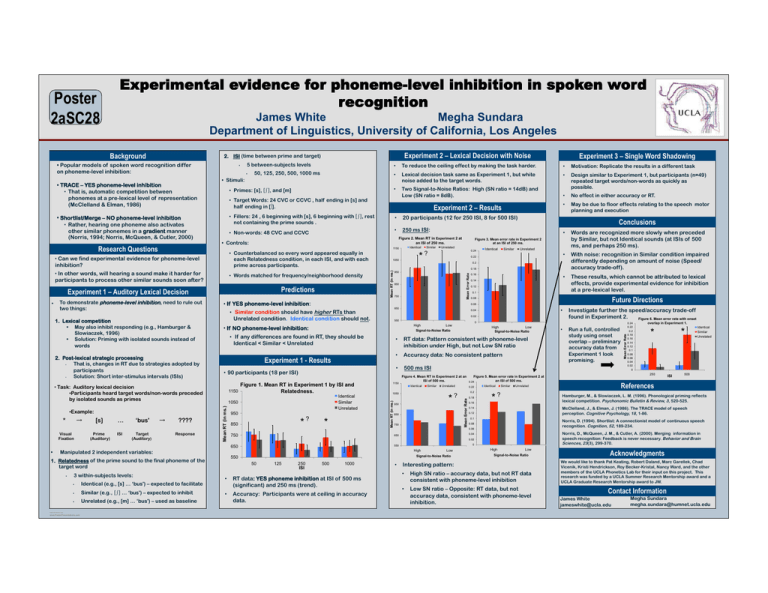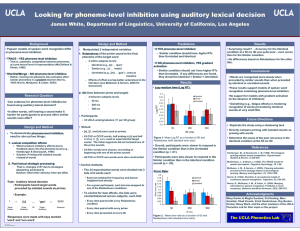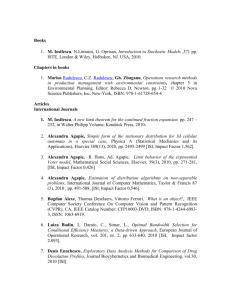Poster 2aSC28 Experimental evidence for phoneme-level inhibition in spoken word recognition
advertisement

Experimental evidence for phoneme-level inhibition in spoken word recognition Poster 2aSC28 James White Megha Sundara Department of Linguistics, University of California, Los Angeles Research Questions 5 between-subjects levels • 50, 125, 250, 500, 1000 ms • Stimuli: • Primes: [s], [∫], and [m] 2. Post-lexical strategic processing • That is, changes in RT due to strategies adopted by participants • Solution: Short inter-stimulus intervals (ISIs) • Words matched for frequency/neighborhood density • Target (Auditory) → ???? Response Manipulated 2 independent variables: 1. Relatedness of the prime sound to the final phoneme of the target word • 3 within-subjects levels: • Identical (e.g., [s] … ‘bus') – expected to facilitate • Similar (e.g., [∫] … ‘bus') – expected to inhibit • Unrelated (e.g., [m] … ‘bus') – used as baseline TEMPLATE DESIGN © 2008 www.PosterPresentations.com Two Signal-to-Noise Ratios: High (SN ratio = 14dB) and Low (SN ratio = 8dB). • No effect in either accuracy or RT. • May be due to floor effects relating to the speech motor planning and execution Predictions Identical * Similar Figure 3. Mean error rate in Experiment 2 at an ISI of 250 ms. Unrelated 0.24 ? Identical Similar Unrelated 0.2 950 850 750 0.16 • These results, which cannot be attributed to lexical effects, provide experimental evidence for inhibition at a pre-lexical level. 0.14 0.12 0.1 Future Directions 0.08 0.06 650 • Investigate further the speed/accuracy trade-off found in Experiment 2. Figure 6. Mean error rate with onset 0.04 0.02 550 High • If NO phoneme-level inhibition: 0 Low High Low Signal-to-Noise Ratio Signal-to-Noise Ratio • If any differences are found in RT, they should be Identical < Similar < Unrelated • RT data: Pattern consistent with phoneme-level inhibition under High, but not Low SN ratio • Accuracy data: No consistent pattern Experiment 1 - Results Figure 1. Mean RT in Experiment 1 by ISI and 1150 Relatedness. Identical Similar Unrelated 1050 950 * ? * 1150 Figure 4. Mean RT in Experiment 2 at an ISI of 500 ms. Identical Similar Unrelated *? 1050 950 850 750 750 650 650 550 Run a full, controlled study using onset overlap – preliminary accuracy data from Experiment 1 look promising. 0.22 0.2 0.18 0.16 Identical Similar Low 250 ISI 500 1000 • RT data: YES phoneme inhibition at ISI of 500 ms (significant) and 250 ms (trend). • Accuracy: Participants were at ceiling in accuracy data. ISI Identical Similar Unrelated 500 McClelland, J., & Elman, J. (1986). The TRACE model of speech perception. Cognitive Psychology, 18, 1-86. 0.14 0.12 0.1 Norris, D. (1994). Shortlist: A connectionist model of continuous speech recognition. Cognition, 52, 189-234. 0.08 0.06 Norris, D., McQueen, J. M., & Cutler, A. (2000). Merging information in speech recognition: Feedback is never necessary. Behavior and Brain Sciences, 23(3), 299-370. 0 Signal-to-Noise Ratio * * Hamburger, M., & Slowiaczek, L. M. (1996). Phonological priming reflects lexical competition. Psychonomic Bulletin & Review, 3, 520-525. 0.04 High 550 overlap in Experiment 1. References Unrelated *? 0.24 0.22 0.2 0.18 0.16 0.14 0.12 0.1 0.08 0.06 0.04 0.02 0 250 Figure 5. Mean error rate in Experiment 2 at an ISI of 500 ms. 0.24 0.02 125 • • 500 ms ISI • 90 participants (18 per ISI) 50 • Words are recognized more slowly when preceded by Similar, but not Identical sounds (at ISIs of 500 ms, and perhaps 250 ms). • With noise: recognition in Similar condition impaired differently depending on amount of noise (Speed/ accuracy trade-off). 0.22 0.18 • Similar condition should have higher RTs than Unrelated condition. Identical condition should not. 850 Conclusions 250 ms ISI: • If YES phoneme-level inhibition: Mean RT (in ms.) • Example: ISI • Design similar to Experiment 1, but participants (n=49) repeated target words/non-words as quickly as possible. 1050 Mean RT (in ms.) • Counterbalanced so every word appeared equally in each Relatedness condition, in each ISI, and with each prime across participants. • Task: Auditory lexical decision • Participants heard target words/non-words preceded by isolated sounds as primes Prime (Auditory) • • Mean RT (in ms.) 1. Lexical competition • May also inhibit responding (e.g., Hamburger & Slowiaczek, 1996) • Solution: Priming with isolated sounds instead of words Visual Fixation Lexical decision task same as Experiment 1, but white noise added to the target words. Figure 2. Mean RT in Experiment 2 at an ISI of 250 ms. Experiment 1 – Auditory Lexical Decision ‘bus' • 1150 To demonstrate phoneme-level inhibition, need to rule out two things: … Motivation: Replicate the results in a different task Experiment 2 – Results • Controls: • In other words, will hearing a sound make it harder for participants to process other similar sounds soon after? [s] • • 20 participants (12 for 250 ISI, 8 for 500 ISI) • Non-words: 48 CVC and CCVC • Can we find experimental evidence for phoneme-level inhibition? → To reduce the ceiling effect by making the task harder. • Target Words: 24 CVC or CCVC , half ending in [s] and half ending in [∫]. • Fillers: 24 , 6 beginning with [s], 6 beginning with [∫], rest not containing the prime sounds . Experiment 3 – Single Word Shadowing • Mean Error Rate • Shortlist/Merge – NO phoneme-level inhibition • Rather, hearing one phoneme also activates other similar phonemes in a gradient manner (Norris, 1994; Norris, McQueen, & Cutler, 2000) • Mean Error Rate • TRACE – YES phoneme-level inhibition • That is, automatic competition between phonemes at a pre-lexical level of representation (McClelland & Elman, 1986) * Experiment 2 – Lexical Decision with Noise 2. ISI (time between prime and target) Mean Error Rate Background • Popular models of spoken word recognition differ on phoneme-level inhibition: OPTIONAL LOGO HERE High Low Signal-to-Noise Ratio • Interesting pattern: • High SN ratio – accuracy data, but not RT data consistent with phoneme-level inhibition • Low SN ratio – Opposite: RT data, but not accuracy data, consistent with phoneme-level inhibition. Acknowledgments We would like to thank Pat Keating, Robert Daland, Marc Garellek, Chad Vicenik, Kristi Hendrickson, Roy Becker-Kristal, Nancy Ward, and the other members of the UCLA Phonetics Lab for their input on this project. This research was funded by a UCLA Summer Research Mentorship award and a UCLA Graduate Research Mentorship award to JW. Contact Information James White jameswhite@ucla.edu Megha Sundara megha.sundara@humnet.ucla.edu





